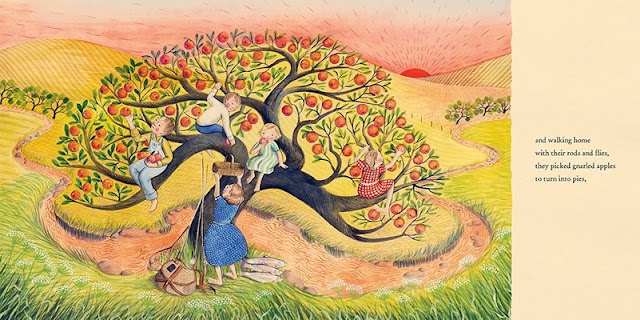This book is a lyrical love letter to the past and to an old house that saw children grow and change until the house itself grew too old to stay standing. While this broken old house could not be rescued by Sophie Blackall, I love that she was able to retrieve so many fragments from the history of the house and then painstakingly incorporate them into her delicate collage illustrations.
Her voice is so authentic recounting the lives of the family with twelve children who lived long ago in this house. There is a beautiful sense of completion when we meet the final and youngest child, now an old lady, who takes her last look around the house before leaving it to nature and tempest. While it is sad, it is also good to see the raw and messy state of the house fifty years after the last family left. From the artist page illustration where we see Sophie Blackall with her materials there is a feeling that even though the house is now gone its spirit will live on.
The author note at the back of the book is essential reading and heartbreaking with those words “a roaring excavator would come and extend its long neck and open its wide jaws, bite through the beams, push over the walls, crunch up the parlor organ … “. I love the way Sophie scattered seeds on the land after the house was gone.
The design of Farmhouse is scrumptious – the embossed cover, the wrap around image on the dust jacket, the view of the inside of the house, a little like a dollhouse, found under the dust jacket, the front-end papers with all the patterns and textures and objects from the house, and the photos at the back of those twenty-one dresses looking like ghosts from the house and along with the old organ. I wish I had a button that was once a shell in the sea - that is the perfect refrain.
This book is sure to delight readers of all ages. The story telling is rich and nostalgic. There is a very strong sense of time and place. The illustrations can be revisited over and over again and each time the discovery of new details will delight children and adults alike. I also love the pace of the illustrations. We move from pages with so much detail and then turn to a quieter page such as the barn milking scene and the apple tree. To my eye those pages and the one where we see the surrounding farmland feel like places where a reader can take a "visual" breath - these are quieter pages.
The rhythm and meter of the narrative is perfect. It undulates and weaves in and out of the family's little life in a playful and surprising way, drawing the reader in to 'eavesdrop' on the life of the family before sending the reader out to explore details gently dropped into the tale such as the button that was once a shell. It made me reach for my own grandmother's button jar to see if I had a shell button like this. IF I had been able to read this book with a group of children my button (like this one below) would have been my starting point.
It has taken me a while to talk about this book because I had to wait until after the CBCA (Children's Book Council of Australia) announced their award winners for 2023 - this waiting is part of being a judge. Farmhouse was shortlisted for the picture book award. The judge's comments were partly written by me, so they do overlap with my comments here.
Here are some review comments:
A lovely, tender reimagining of people in a long-past time and place. Kirkus Star review
I loved watching Sophie Blackall share her process and art creations for this book on Instagram. Here is one moment. Sophie Blackall talks to the Horn Book magazine. IBBY President Dr Robyn Sheahan-Bright has prepared some outstanding teachers notes. Here is another interview with Sophie by Parnassus Books in Nashville.
There are hundreds of decisions to be made on every page of a picture book. In this book, in this family, there are twelve children, and they all have chores and I want it to be historically accurate, but I also want to give the characters depth and not lock them into gender roles.
The perfect comparison text is The Little House.
I also suggest looking for these:










No comments:
Post a Comment